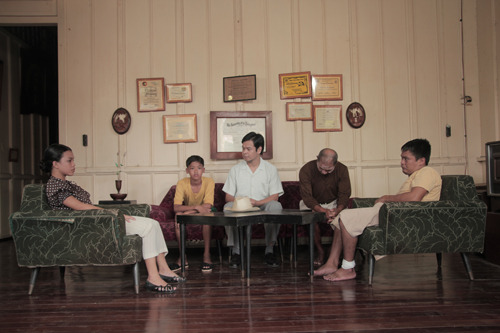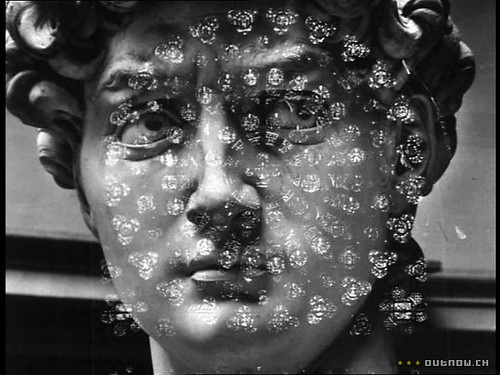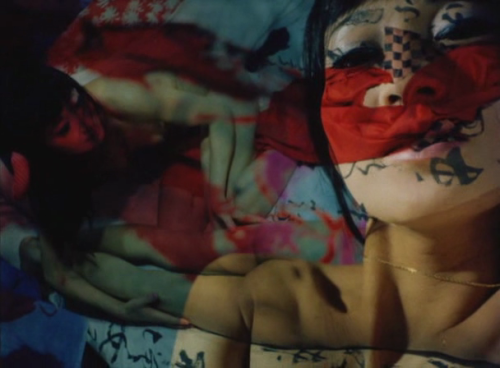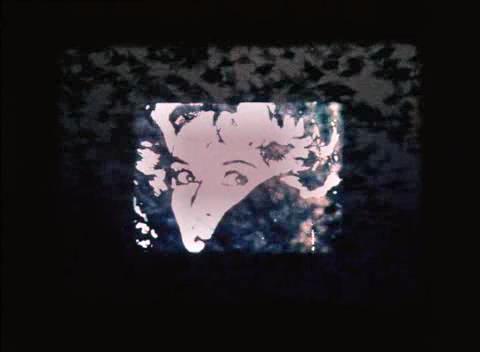for you who's sleeping by now... +
from Entranced Earth (Glauber Rocha, 1964)
To open my year 2011, I watched Sofia Coppola's Somewhere (2010). There in my bed, half past two in the morning, I tucked myself after a light New Year's Eve dinner. I was obliterated by the thought that another year had gone by. There I was, watching Somewhere, lost in my thoughts. Coppola's film felt empty; the last frame ended silently; and so was my room, filled with memories, dark and lonely. One wonders how one can suddenly feel terribly alone; all seemed lost; a year beginning, a year ending. The sky, though dark, was light, happy and simple. No clouds above; only stars and a moon, smiling, cordially greeting the meadows, the wild grass, the empty lot by that side of Santiago Street a happy year ahead.
My family love this quietness around me. Provincial quietness, they say. Normally, one wakes up at four in the morning to water the plants, to feel adroitly wrapped by the night fog, to hear the trees howling with the wind, to die slowly in oblivion. There is more to dying at this hour of day than living. Yes, indeed, provincial life can be suffocating, having live in the city for more than five years. Gustave Flaubert's novel Madame Bovary has written immensely about these feelings and how ones sexual life, if repressed, can be self-destructive. But that is the case of Emma Bovary, unable to assimilate herself into the quietness of her provincial home probably because she was a woman of vision, of beauty, of intelligence that with such an unadventurous atmosphere at Rouen in Normandy she succumbed to her own nature thereby following herself; a woman's choice; a courageous act indeed, and so are the many feminine characters in literature who fought 'till the end like Tolstoy's Anna Karenina and Judith Shakespeare in Virginia Woolf's A Room of One's Own. But yes, indeed, they are victims of society's whim, being demonized as adulterous, indomitable women who all failed to subscribe to the conventional thought that a woman is a tamed creature. This geopolitics in Flaubert's novel concerns me extremely and I found myself extending it to the nature of cinema.
Cinema is a battle, an endless ramifications of its form creating large volumes of light and darkness; birthing to what seems to be a Methuselah of total art too intelligent to be tamed by the capitalist society. How cinema age so fast these days, that at one point, you look at screen and bedazzled by the total experience of a 3D movie which, a few decades ago, most old people have not experienced. If suffocated, if restrained, if subjected to banalities of life, cinema will revolt. Politics, fashioned like a constant adversary to most art forms these days, shaped cinema to be subversive in nature. Filmmaking practices depends so much on the current milieu and geopolitics that filmmaking standards cannot be universalized within a specific location or time. Nor can one say that most filmmakers directs uniformly over his filmmography and that each of his film resembles, in terms of style and themes, the other. A filmmaker, like most artists, always changes perspective since filmmaking and cinema itself is mutable and impermanent. It is valid to say therefore that Auteur Theory is dead: a thing of the past, a European conundrum, a pop theory not enough to encompass all of cinema.
What's more interesting perhaps is the ability of cinema to elicit the power of opinion from the audience. If the art of film making is the back bone, film criticism is the soul of cinema. It did not only gave film a chance to be spoken as an experience, but also it gave film a deep and glaring metaphysical gaze into itself, into the eternal verities of life.. A opinion about a film, even roughly written and said, reassures the film's existence to its immediate cultural surroundings. A criticism invites viewers to think more deeply the films they've seen, asserting to them that this kind of art is one of the most complex they can experience.
And so the issues goes on; on and on, accruing from that moment I saw Coppola's Somewhere last January the first until now, having realized so much of what cinema has to offer. Leaving before me are traces of indecision; of immaturity; of lack of temperance; of my old self. No longer do I see cinema as something to be consumed. Finally, cinema presented itself to me somewhere between watching Jonas Mekas autobiographical sketch entitled As I Was Moving Ahead Occasionally I Saw Brief Glimpses of Beauty (2000) and Lav Diaz' staggering self-portrait of his own cinema, Century of Birthing (2011). But it was too fast and complex for me to understand, to comprehend, to deal with. It wrestles with me in dark, in the deep dark woods in front of our provincial house.
***********
TOP 10 FILIPINO FILMS OF 2011
In a period of six hours, Lav Diaz gave us an unrelenting epic view of his own cinema from its conception to its birth. Not outwardly stated in the film, Century of Birthing sits on the premise that to give birth to a new cinema, one has to break old traditions ("the cult") which deluded the minds of the followers. One has to "rape" these monolithic traditions and impregnate them with truth and visions of reality in order for a new cinema to begin. The film centers on Homer, a filmmaker having a developmental crisis with his film "Babae sa Hangin", Lav's work-in-progress film. As Homer resolves his issues in finishing his film, he encounters basic questions like "What is Cinema?", "What is the role of an artist, of a filmmaker?" These questions reverberated throughout the film as if it was Lav Diaz speaking to us.
2 | Buenas Noches, España (Raya Martin)
Buenas Noches, España may appear to be a psychedelic film style-wise with its repetitive shots and shifting monochromatic gradients, but if one reassess it, Raya's style in Buenas Noches has a great reference to TV especially with the SMPTE color bars. These color bars are usually seen during late nights on TV when the channels are offline. This approach was hinted by the couple sitting on the chair watching television on the first part of the film. The sound used in the film also mimics the sound from the SMPTE color bars. Raya used this concept of color bars to tell the tale of two couples on their journey along a countryside at Spain and their discovery of a forgotten history between their country and the Philippines. This avant-garde film surely asserts everyone that cinema is an experience and should not be taken too intellectually.
3 | Palawan Fate (Auraeus Solito)
"Solito's personal reflections on Palawan's history has assimilated within the aesthetics of his film. He uses it to construct the film's unique spatial and temporal unity of Palawan's struggles to reclaim their degrading landscape and to revoke the lost spiritual identity of the region after years of captivity from foreign forces. This pluralistic and personal approach of creating a filmic world is itself a creative achievement in contemporary Philippine cinema. It resurfaces the rarely explored linkage of cinema and tribal history told through a personalize spatio-temporal design. Solito adapts the non-linearity of the oral tradition his of tribal ancestors to his film by fusing it to its editing. He places great importance on this constructional principle that with this, the film can be situated within the discourse of the loob-labas (internal-exteral) system, one of the central discourse in Filipino Psychology, indigenous to the Filipino self." [continue reading]
Loy Arcenas' gem was a surprise black comedy at this year's Cinemalaya Film Festival. The film is bathed with rich music, colors and production design, each frame invites the viewers to relinquish the nostalgia of the lost era of opera music. The film merges the old and the new, the young and the old, the birth and the death in a family.
5 | Sa Kanto ng Ulap At Lupa (Mes de Guzman)
Four different kids from different family backgrounds struggles to survive independently after they left their parents. They stayed together in one roof and tended each other like brothers. The film, incredibly photographed to suit the ennui exuded by its setting, appears to be a pursuit of freedom from the harsh realities of rural life in poverty. With such a humanist eye, Mes de Guzman narrates to us a tragedy and sensibilities of the Filipino youth.
6 | The Moon is Not Ours (Jon Lazam)
Jon Lazam's The Moon is Not Ours is a sublime reflection of space, time and emotions. His earlier film, Tagpuan (2009) also hints an exploration of these themes. The Moon has an incredible reticent to transcend the local traditional filmmaking as it records unrelated and deeply personal events. It forges its own language to speak in terms of image ---- and image alone. [watch it here]
7 | Six Degrees of Separation from Lilia Cuntapay (Antoinette H. Jadaone)
Fashioned as a mockumentary to reminisce the life of a forgotten but great horror extra Lilia Cuntapay, it provides a lot of insight about the current entertainment industry more than any other film this year. Jadaone constructs a unique network of information about Lilia, half invented, half based on true life events to create a humorous portrait of Lilia's quest in claiming her Best Actress Award. Jadaone's unique screenplay, filled with candidness and bittersweet surprises, is surely written for the audience to love.
8 | Ang Sayaw ng Dalawang Kaliwang Paa (Alvin Yapan)
When areas in arts like cinema, dance and literature collide, like how painting and cinema molded together in Andrei Tarkovsky's Andrei Rublev (1966), the effect produces a sublime material well encrypted with lyricism, mythologies and artistic sensibilities. In Yapan's Sayaw, feminine voices in Philippine poetry flow throughout the film in a trance. The poems were sang and the actors meld to these lyrical trances assimilating to the nuances of its symbols. The film achieves a homoerotic atmosphere seemingly hidden beneath a wall of connotative hints and slips, a proof that Yapan has a keen mastery in storytelling and frame composition.
9 | Big Boy (Shireen Seno)
Deep within Seno's aesthetics, one can see a familiar scene of a tropical forest often depicted in most of South East Asian films nowadays especially in the films by Apichatpong Weerasethakul. But this one seemed to be made like a home movie inspired by Mekas'. Big Boy commemorates the old rural past the 60s centering on a family living at a quiet rural town of Antique. It is teeming with youthful exuberance and innocence in depicting a boy whose only dream is to re-unite a family under one roof. At the end of the film, as the shots lengthen, the film achieves immortality.
10 | Brownout sa Neighborhood Namin That Day (Judd Figuerres)
Judd Figuerres' Brownout has an absurdist sensibility comparable to Edwin's Blind Pig Who Wants to Fly (2008). This surrealist drama deconstructs the anxiety of a modern Filipino family preparing for Christmas Eve: a family whose members are too individualize with themselves lacking the traditional solidarity of a "Close Family Ties". The film provides a critique to the traditional perspective of a family. The film's simplicity and remarkable restraint in camera work helped in building up the strange and uncomfortable atmosphere and finishes off with a surprising climax.
*************
TOP 25 NEW DISCOVERIES OF 2011
1 | The Age of the Earth (Glauber Rocha, 1980)

Glauber Rocha's The Age of the Earth tops my newly discovered films this year because of its uttermost beauty, originality and radicalism. There I was, frozen in front of the screen the whole time, voicing no other words but beauty. I don't know why some people hate it so much, but probably because of it's inaccessibility in storytelling. But it is definitely one of the most beautiful avant-garde films I have seen --- a subversive visual poetry, staggered, absurd and anthropological. It is a well-designed, well-orchestrated assimilation of visual and auditory polemics on the hypocrisy of Christianity, international politics and capitalism. A must-see for avant-garde and political film enthusiasts, such a tour-de-force, it rips my brain off.
2 | As I Was Moving Ahead Occasionally I Saw Brief Glimpses of Beauty (Jonas Mekas, 2000)
 As I Was Moving is one of the most moving films I've seen this year. In its five hours of sheer beauty, Jonak Mekas shows us a collection of random footage he shot for his whole life. I will always remember this this film as a film that radically changed the way I see cinema now, as I've said in an earlier post: "...Cinema is something not to be thought upon, as some intellectuals put it so well; but it is something to be seen, something to be experienced, something to be remembered. Disappearing behind me are the prejudices, the politics, the intellectual profanities I had endured; all gone. All what is left are fragments, memories, feelings, and the joy of seeing an image."
As I Was Moving is one of the most moving films I've seen this year. In its five hours of sheer beauty, Jonak Mekas shows us a collection of random footage he shot for his whole life. I will always remember this this film as a film that radically changed the way I see cinema now, as I've said in an earlier post: "...Cinema is something not to be thought upon, as some intellectuals put it so well; but it is something to be seen, something to be experienced, something to be remembered. Disappearing behind me are the prejudices, the politics, the intellectual profanities I had endured; all gone. All what is left are fragments, memories, feelings, and the joy of seeing an image."3 | Death in the Land of Encantos (Lav Diaz, 2007)
This is the longest film I've watched for the year: nine hours in one seating. It never occurred to me that time warps itself when you're watching a Lav Diaz. You do not look the clock and say that you've had enough. But as the narrative goes by and the long takes lengthen, you contemplate further about cinema. His lingering takes reinforces us the nuances we never encountered in conventional films. Each of the five to eleven minute takes are composed with intrigues, politics and discussions of art. In Death in the Land of Encantos, takes us into the central theme of the film: the struggle of radical artists against the impunity of military forces. It amounts to voluminous feelings of contemplation, of information about these struggle for revolt against the oppressors of Philippine society: capitalist forces, corrupt government officials, and bourgeois, neoliberal thoughts that poisons us until now.
4 | The Hour of the Furnaces (Octavio Gentino and Fernando Solanas, 1968)
The Hour narrates to us the age-old liberation of Latin American from feudalism in the 1800s to the neocolonialism of the mid 1900s. It centers on the people's liberation of Argentina and fates of its revolutionary leaders like Che Gueverra. What is great about this four-hour documentary was it astute straight-forwardness approach to the topic: Latin American revolution. Rather than delineating from the topic with sappy connotations and invented narrative, it uses factual information and accounts from sourced materials.
5 | Vive L’Amour (Tsai Ming-Liang, 1994)

Vive L'Amour crept inside me slowly that at the last frame, I cannot help myself crying realizing how alienating urban life can be. Yes, it is a film about extreme alienation brought about by the non-cohesive life in urban centers such as Taipei in Taiwan. Each of the characters, like us, longs to find a connection in this severed world of empty desires and exchanges.
6 | Black God, White Devil (Glauber Rocha, 1964)
This is a great, great piece of filmmaking that mirrors the political and cultural tension of 1960s Brazil. A film fashioned to be one of Brazilian Cinema's defining film in its revolt against feudalism, poverty and corruption. It should have won the Palme d'Or during Cannes Film Festival 1964 over Umbrellas of Cherbourg (1964).
7 | The Golden Thread (Ritwik Ghatak, 1965)
My first Ghatak, I was drawn to it slowly. It's about a devastating tale of a woman whose only wish in life is to seek for social stability: a family, a comfortable atmosphere at home and true happiness. A truly wonderful film, masterfully directed by one of Indian Cinema's greatest director with near perfect compositions and sublime editing, approximating the anxiety of the India's social liberation of the 1950s to 1960s.
8 | Syndromes and A Century (Apichatpong Weerasethakul, 2006)
Apichatpong Weerasethakul's Syndromes and a Century demands more than analysis because it touches an unfamiliar territory a few of us, or only Apichatpong, have access to. The spirit world for Joe is an extension of physical filmic space and time. In Syndromes, the filmic spaces are not mere spaces themselves but passageways to other universes. The characters are transitory figures; impermanent; and participants of supernatural processes. Each of them are ephemeral, disappearing and appearing in mundane spaces: doorways, rooms, forests. Aside from their constantly evolving spatio-temporal functions and their apparent astral projections across parallel universes, each of them have political functions that ignites rethoric about the recent upheaval in the norther part of Thailand. Apichatpong subjects these figures with agenda and luminosity giving each of them spiritual conquests and past lives.
9 | Refrains Happen Like Revolutions in A Song (John Torres, 2010)

"John Torres’ audacious experimentation in Ang Ninanais sits within Deocampo’s illustration of the local counter-cinema: a counter-cinema that do not only collects the cultural and political ideologies of its time but also opens new questions to aesthetics akin to its revolutionist visions. In its effort to destroy the tradition of illusionist cinema, Ang Ninanais pedagogically construct an improvised history that opens debates in politics, ideology and the evolution of film language." [continue reading here]
10 | Once Upon A Time There Was A Singing Blackbird (Otar Iosseliani, 1970)
The last frame refurbishes my initial account of the story. This is more of a film about time and how we should spend our lives without taking it for granted. Once Upon A Time is a film about events and people surrounding the life of Guia, the main character. There wasn't much of a visual flare, if you're looking for it in this film, but its magic lies in its editing and camera movement as it unsteadily portrays the routine hopping of the character from one place to the other. It is a film for busy people who do not know how busy they are---like me.
11 | Noite Vazia aka Men and Women (Walter Hugo Khouri, 1964)
A Brazilian film in the 60s that totally surprised me this year. It verges away from Rocha's rich polemics and settles between the strangeness of Antonioni's L'Eclisse (1962)and the visual asceticism of Ingmar Bergman. Khouri subjects the film with a rich sepia-tone cinematography making it a visually lavish, seductive orgy of two men with two women.
12 | The Fourth Dimension (Trinh T. Minh-ha, 2001)
Ming-ha has created a companion piece to Chris Maker's Sans Soleil (1983). Ming-ha,being an academic herself, personally shaped this as her own critical essay about travel, time and culture.
13 | The Green Ray (Eric Rohmer, 1986)
"Rohmer made this film for his audience especially for those who have lost their hope for love. Rohmer is aware of these moments. He used cinematic techniques to illustrate the feelings of his characters by placing them in environments that would highlight these emotional tonalities. It is as if with the subjective framing of the green ray in the last scene, Rohmer alludes to the alienation of the modern times. For everyone who has lost it, Rohmer conjures a green ray to let those people experience it at first hand in cinema. But it only remains there as an illusion of hope. And upon exiting the cinema, one asks: when can I see a green ray myself?" [continue reading]
14 | Throw Away Your Books, Rally in the Streets (Shuji Terayama, 1971)
"Goodbye, Cinema!"
15 | The Falls (Peter Greenaway, 1980)
It is such a great avant-garde film. For 3 hours, you'll be compounded and saturated by an invented ornithological world full of substitutions, bird's name, accounts of flight, catalogs, lists, exploring image-voiceover destructive-constructive relationship. The film is a deconstruction the mythology of Icarus' fall: the never-ending quest for man's flight. With 92 accounts of people surrounding a certain VUE (Violent Unknown Event), Greenaway presents a postmodernist view of the Icarus' fall. He sidestepped the vicious approach of the traditional narration by focusing on found details and invented language to narrate the myth.
16 | The White Funeral (Sari Dalena,1997)
The film illustrates the dynamic cycle of life and death. Using a rich imagery of symbols, superpositions and animation, Sari lyrically explores the destruction of Lahar in Zambales and the fate of its victims. It looks like a companion piece to Tree of Life (2011) and Aureaus Solitos' Ang Maikling Buhay ng Apoy (1995). The film is such a rare feat for a Filipino film to achieve so much transcendence to think that this has been in the 90s where only a few have dared to dwell into this realm of cinema.
17 | La Libertad (Lisandro Alonso, 2001)
"Films like La Libertad (2001) disconnects us from this new cultural hegemony of pseudo-commercial films and takes us to the center of cinema itself: the persistence of vision in twenty-four frames per second. La Libertad brushes through a man's life as if it was a painting from a lost time. Like still life paintings of Cezanne, the film can be 'hanged' on walls of one's house and let it breathe through that space connecting volumes of emotions. It is through this method, the manifestation of La Libertad as some sort of a moving painting, that cinema has triumphed in resuscitating itself." [continue reading]
18 | Yearning (Mikio Naruse, 1964)
If there is such a thing as a perfect film, Yearning is one of them. The ending sweeps you away like a bomb, it leaves you stunned; burned in disbelief. But yes, movie characters are entitled to mishaps, to heart-breaks, to the rough world called life. Tragic! The pain lingers still, as one audience puts it: "A man is carried away. A woman looks after him with a sad face. A viewer is stunned. A film achieves immortality." A hundred light years away from Ozu, there lies Naruse, equally restraint in style, more accessible and underrated.
19 | Intentions of Murder (Shohei Imamura, 1964)
Intentions of Murder evokes a dragon woman, a woman rejected by her family: her cold husband, her son, and her in-laws. Throughout the film she struggles to overcome her love affair with a thief which for her, a sexual awakening. This erotically charged masterpiece by Imamura has a composition similar to Ozu, but Imamura derided his influence with Ozu by moving the camera in a 60s fashion of cinema verite. A question remains whether Imamura's radical approach is influence by French cinema of the 60s.
20 | Les Rendez-vous d'Anna (Chantal Akerman, 1978)

"A film of enchanting quality with a striking minimalism. Its approach is not as extreme as Chantal Akerman's minimalist gem Jeanne Dielman, 23 Quai du Commerce, 1080 Bruxelles (1975). This is because in Les Rendez-vous d'Anna has an exacting cross-hairs of exploring the relationship between space and the main character's resonating emotional vacuity. Crossing within the threshold of perceptual experience, I encounter numerous instances in the film wherein the Anna is placed with comparison to empty spaces. This is a bit more functional and more purposeful than what she did in Jeanne Dielman. This is a notable improvement from the solidified position of Jeanne in her 1975 film. The spaces to which Anna move as if in solitary trance are narrative elements themselves, as if these spaces are characters in the story. It is as if these vacuous spaces communicate with the viewers, narrating meditatively the alienation of Anna in her journey home." [continue reading]
21 | Brand Upon the Brain! (Guy Maddin, 2006)
This is my favorite comedy film of the year. Guy Maddin never failed to make me laugh with his sinister jokes and banters and oh, occasional incest. Also, Maddin's films are filled with nostalgia. "Memories! Oh Memories." Maddin masters silent cinema by exacting the look of silent films. He creates this comedic farce of a film via exaggeration in acting, visual elements and, to add a modern flare, lesbianism and sci-fiction.
22 | I Can't Sleep (Claire Denis, 1994)

23 | Kairat (Darezhan Omirbaev, 1992)
With deep compositions and great focus on framing, Omirbaev immerses us into the life of a mysterious character named Kairat with poetic subservience. A look at adolescence as Bresson would look at in his The Devil, Probably (1977) but of a newer kind. Its sparsity in aesthetics and unique method of characterization distinguishes it from many 90s films.
24 | Taxi Zum Klo (Frank Ripploh, 1980)

If The Tree of Life have showed us both the veracity and strangeness of life, Frank Ripploh's Taxi Zum Klo (Taxi to the Other Side, 1980) narrates life as it is. Strangely, I do love Frank Zipploh's autobiographical account of his sexual life. It reminds me how such vision of reality and self-introspection affect our constructional principles as artists. Ripploh's self-exposition in the light of gay activism around the world in the late 1970s and early 1980s is historically tangent to gay liberation. As opposed to one-act self-expositions of today's filmmakers such as Vincent Gallo in Brown Bunny (2003), Ripploh's version is less self-absorbed and more honest. It has a well-adjusted, well-balance politics of the external-internal voice of the filmmaker. He narrates the sequences linearly and follows a routine. Momentarily, non-diegetic insertions of select silent films connotes Ripploh's admiration to film history as an extension of the mind or in a general sense, film as an extension of the mind of its characters. This may intuitively lead to the personla view that Ripploh is he, himself, a cinephile. He only created two film in his life, Taxi Zum Klo and Taxi nach Kairo, which was the continuation of Taxi Zum Klo. He died of cancer last 2002.
25 | A Short Film About Indio Nacional (Raya Martin, 2005)
Raya Martin's film A Short Film About Indio Nacional evokes the lost age of silent cinema in the Philippines, an era long gone; and only traces are left for Martin to look back. Martin retraces his steps, with a lyrical vision, into a 1890s life in a small village. With a masterful cinematography and elusive images, Martin elicits his emotional rather than 'historical' gaze into the spirit of the time during the First Revolution of 1890s in the Philippines.
*******
HAPPY NEW YEAR!
*******
+ special thanks to my partner, Chris, for guiding me and suggesting some of these wonderful films to watch. 











%203%20c.jpg)
















